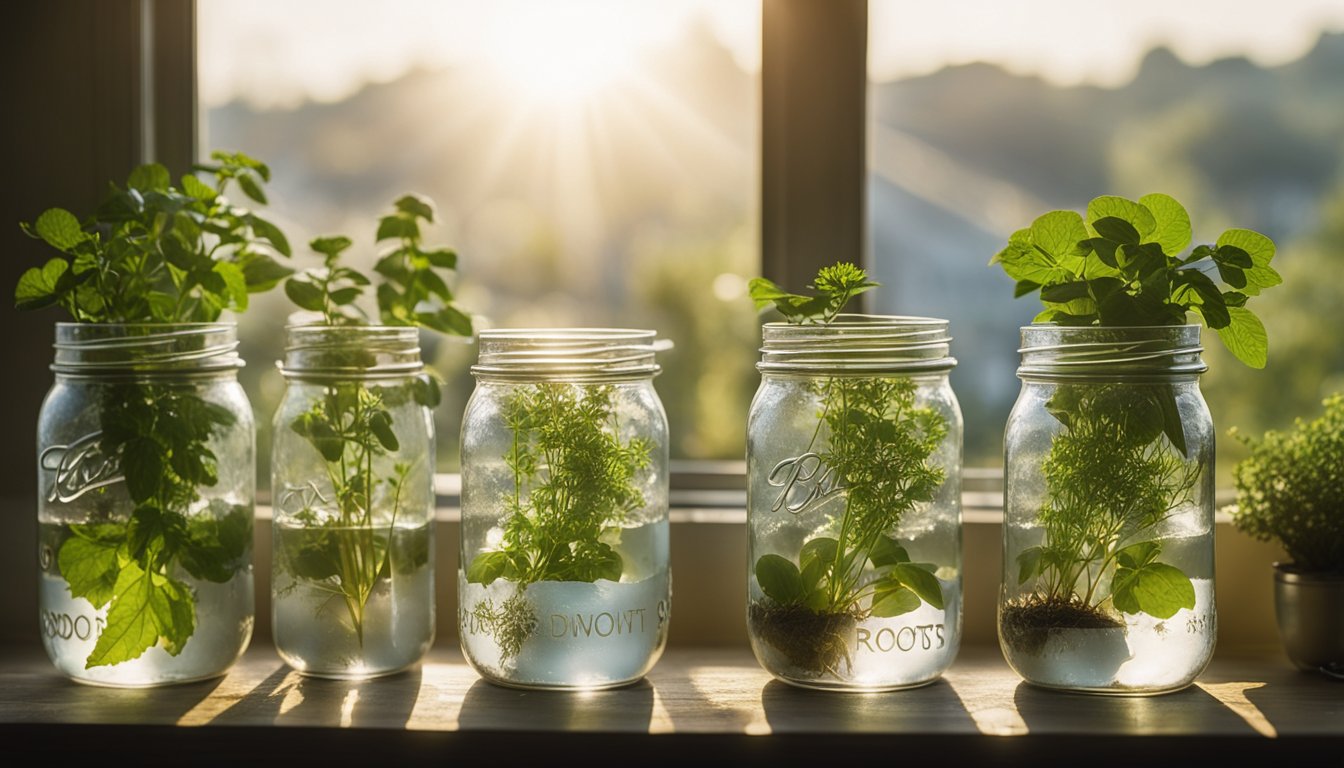Imagine transforming your living space into a lush oasis without the hassle of soil. Growing plants in water isn’t just a trend; it’s a simple, rewarding way to bring greenery into your home. Whether you’re a seasoned gardener or a curious beginner, this method opens up a world of possibilities.
Overview of Growing Plants in Water
Growing plants in water offers a simple way to bring greenery into your home. Many people enjoy this method because it eliminates messy soil. All you need is a container filled with water and a plant cutting.
This process encourages quick rooting. For instance, herbs like basil or mint thrive in water. Watching roots develop can be quite satisfying. Plus, you’ll notice how clean and bright your space feels with plants around.
Choosing the right plants is essential for success. Some hardy plants such as pothos or spider plants adapt well to water. Regularly changing the water keeps it fresh and encourages healthy growth.
Using different containers adds a fun element to the process. You can try glass jars, vases, or even recycled bottles. Each choice can create a unique display in your home.
Growing plants in water not only beautifies your space but also provides an opportunity to connect with nature. It’s a rewarding hobby that doesn’t require much time or effort. Why not give it a try?
Benefits of Growing Plants in Water

Growing plants in water comes with many advantages. This method makes gardening straightforward and enjoyable, appealing to everyone from beginners to seasoned greenthumbs. Here are some key benefits of this technique.
Easy Maintenance
Maintaining water-grown plants is simple and low effort. I only need to check the water level and change it regularly. Unlike soil, there’s no need to worry about pests or weeds. I just make sure the plant cutting receives adequate light, and it thrives. Clean containers also prevent algae growth, keeping the whole process pretty neat and tidy. Plus, the clear water lets me admire the roots as they grow. It’s like having a front-row seat to a natural show.
Faster Growth Rates
Water encourages rapid growth in many plants. I’ve noticed my basil and mint sprout much quicker in water than in soil. Root development happens swiftly, which means I can enjoy fresh herbs sooner. Plants like pothos and spider plants excel in this setting, often showing visible growth within days. With just a bit of patience and regular care, I find that these beauties flourish faster than I expected. Growing plants in water really makes the waiting worthwhile.
Suitable Plants for Water Cultivation
Growing plants in water isn’t just easy; it’s fun too! Certain plants shine in this method, making them perfect for indoor or outdoor settings.
Indoor Plants
Pothos thrives in water. Its heart-shaped leaves add charm to my space. Spider plant also does well with roots submerged. It’s great for hanging baskets. I often see peace lilies in the water too. They bloom beautiful white flowers and make my home feel fresh.
Herbs like basil and mint flourish in water. I cut stems and place them in jars. They love the moisture and grow quickly. Mint even doubles as a fragrant room freshener!
Some aquatic plants add flair to the decor. Lucky bamboo grows vigorously in a vase. It brings a touch of Zen to my home. Another favorite is the snake plant. It tolerates low light and looks sleek in a water bowl.
Outdoor Plants
Several outdoor plants love water, too. Mint and basil can grow beautifully on the patio. They thrive in containers filled with water during hotter months. I sometimes put rosemary in a jar when I want quick access to fresh herbs.
Coleus adds vibrant colors to outdoor gardens. Placing cuttings in water encourages them to root quickly. I often enjoy watching their colors brighten my balcony.
Water lilies are a lovely choice for ponds. They float gracefully, creating a picturesque scene. If I had a pond, I’d definitely consider adding these.
Using the right plants makes growing in water a delightful experience. I’ve enjoyed watching plants flourish in jars and pots around my home.
Techniques for Growing Plants in Water

Growing plants in water involves a few straightforward techniques that make this method effective and enjoyable. It’s like gardening without the mess, and I get to watch roots magically appear. Here are two popular methods I often use.
Hydroponics
Hydroponics means growing plants without soil. Instead, I use nutrient-rich water to feed the roots directly. This technique works wonders for many plant types. I mix a water-soluble fertilizer into water, creating an ideal environment for plant growth.
Plants like tomatoes and lettuce thrive in these conditions. I chose a container and set up a system to keep water circulating, which ensures the roots remain healthy. It’s like setting up a mini aquarium for my plants, but thankfully, vegetables don’t swim!
Propagation in Water
Propagation in water is an easy way to create new plants from cuttings. I select healthy stems from my existing plants, making sure to cut just below a node. Afterward, I place these cuttings in a glass of water and find a bright spot for them.
They usually start developing roots in a week or two. Watching roots grow feels like magic. I love to keep my cuttings in clear jars, so I can see the progress. Once they produce roots about two to three inches long, I transfer them to a pot or leave them in water for a unique display. Propagation not only multiplies my plants but also fills my home with greenery that shines brightly.
Common Challenges and Solutions
Growing plants in water can be rewarding, but certain challenges often arise. Understanding these issues helps create a thriving environment.
One common problem is algae growth. Algae can clutter your container, blocking light and oxygen for the plant. To fix this, keep your container in a shaded area. Regularly change the water to keep it fresh. Using a darker container can also help minimize light exposure.
Nutrient deficiency can affect plant growth. While water alone supports roots, it may lack necessary nutrients. Adding liquid fertilizer every few weeks supplies essential elements. Always follow the product’s instructions for safe usage.
Rotting stems cause concern as well. If the cutting sits too long in water, it can rot. To prevent this, trim the stems every few weeks. A clean cut encourages fresh growth. Make sure your cutting has no leaves submerged in water, as this can contribute to rotting too.
Pest issues might pop up, even in water. While growing in water reduces pests compared to soil, they can still appear. Inspect your plants regularly for tiny bugs. A simple soap solution can effectively manage pests without harming the plant.
Plant growth rates can vary. Some plants flourish rapidly while others take their time. Patience plays a role here. Monitoring your plants allows you to adjust care techniques based on their needs.
Another issue is temperature sensitivity. Water plants generally prefer stable temperatures. If a plant is exposed to drafts or direct sunlight, it may struggle. Place your container in a spot that maintains a comfortable temperature.
Managing these challenges creates a more enjoyable experience. Overcoming obstacles brings satisfaction and builds confidence as a gardener. With some care and attention, growing plants in water becomes a delightful journey.
Before You Go – Growing Plants in Water
Growing plants in water has truly transformed my approach to gardening. It’s not just about ease and accessibility; it’s the joy of watching roots develop and knowing I can beautify my space with minimal effort. I love how this method encourages creativity with containers and allows me to connect with nature right at home.
Whether I’m nurturing herbs or vibrant indoor plants, the satisfaction of thriving greenery in water is unmatched. By choosing the right plants and staying mindful of their needs, I can enjoy a lush environment while sidestepping common gardening hassles. This rewarding hobby continues to inspire me, proving that with a little care, anyone can cultivate a thriving indoor oasis. Don’t forget to add The Herb Prof to your favorites so you don’t miss out on future articles.
References – Growing Plants in Water
Little Herb Encyclopedia, by Jack Ritchason; N.D., Woodland Publishing Incorporated, 1995
The Ultimate Healing System, Course Manual, Copyright 1985, Don Lepore
Planetary Herbology, Michael Tierra, C.A., N.D., Lotus Press, 1988
Handbook of Medicinal Herbs, by James A. Duke, Pub. CRP Second Edition 2007
The Complete Medicinal Herbal, by Penelope Ody, Published by Dorling Kindersley
Check the Following Articles
What Is Arrowroot? Discover Its Uses and Health Benefits
Top 3 Healthier Substitutes for Butter
Planting Onions from Seed: A Step-by-Step Guide
Tulsi Holy Basil Tea for Health and Wellness
Frequently Asked Questions – Growing Plants in Water
1. What is water gardening?
Water gardening involves growing plants in water instead of soil. This method is easy and accessible for both novice and experienced gardeners, making it a popular choice for home decor.
2. Which plants are best for growing in water?
Great options for water growth include pothos, spider plants, basil, and mint. Indoor and aquatic plants also thrive, offering beauty and functionality in your space.
3. How do I change the water for my plants?
Regularly change the water—around once a week—to promote healthy growth and prevent algae buildup. Clean the container to ensure a fresh environment for the roots.
4. What are the benefits of growing plants in water?
This method eliminates soil mess and encourages faster growth. It’s low-maintenance, enhances home aesthetics, and allows for easy monitoring of root development.
5. How does propagation work in water?
Propagation involves placing healthy plant cuttings in water, where they can develop roots in one to two weeks. This technique allows for easy plant multiplication and adds greenery to your home.
6. What problems might I encounter with water gardening?
Common issues include algae growth, nutrient deficiencies, and rotting stems. Managing light exposure, adding fertilizers, and monitoring water temperature can help mitigate these challenges.
7. Is hydroponics the same as growing plants in water?
Hydroponics is a specific type of water gardening where plants grow in nutrient-rich water without soil. It often involves more complex setups for maintaining optimal conditions for growth.
8. How can I enhance the aesthetic appeal of my water plants?
Using various containers, like glass jars or recycled bottles, can creatively showcase your plants. Choosing vibrant herbs and aquatic plants adds a visually rewarding dimension to your decor.

